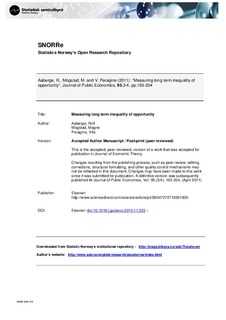| dc.contributor.author | Aaberge, Rolf | |
| dc.contributor.author | Mogstad, Magne | |
| dc.contributor.author | Peragine, Vito | |
| dc.date.accessioned | 2011-11-29T10:14:49Z | |
| dc.date.available | 2011-11-29T10:14:49Z | |
| dc.date.issued | 2011 | |
| dc.identifier.citation | Journal of Public Economics, Vol. 95, no 3-4, 193-204, 2011 | no_NO |
| dc.identifier.issn | 1879-2316 | |
| dc.identifier.uri | http://hdl.handle.net/11250/178140 | |
| dc.description | This is the final text version of an article that was accepted for publication in Journal of Public Economics. It may contain insignificant diferences from the journal's pdf version. | no_NO |
| dc.description.abstract | Abstract
In this paper, we introduce a new family of rank-dependent measures of inequality and social welfare consistent with the equality of opportunity (EOp) principle. The proposed framework can be used to measure long-term as well as short-term EOp, depending on whether we let permanent income or snapshots of income form the basis of the analysis. Furthermore, it allows for both an ex-ante and an ex-post approach to EOp. There is long-term ex-post inequality of opportunity if individuals who exert the same effort have different permanent incomes. In comparison, the ex-ante approach focuses on differences in the expected permanent income between groups of individuals with identical circumstances. To demonstrate the empirical relevance of a long-run perspective on EOp, we exploit a unique panel data from Norway on individuals' incomes over their working life span. This allows us to examine how well analysis of opportunity inequality based on snapshots of income approximate the results based on permanent income. | no_NO |
| dc.language.iso | eng | no_NO |
| dc.publisher | Elsevier | no_NO |
| dc.subject | Equality of opportunity | no_NO |
| dc.subject | Income | no_NO |
| dc.subject | Social welfare | no_NO |
| dc.subject | Inequality | no_NO |
| dc.subject | JEL classification: D71 | no_NO |
| dc.subject | JEL classification: D91 | no_NO |
| dc.subject | JEL classification: I32 | no_NO |
| dc.subject | Scientific article | |
| dc.title | Measuring long-term inequality of opportunity | no_NO |
| dc.type | Journal article | no_NO |
| dc.type | Peer reviewed | no_NO |
| dc.subject.nsi | VDP::Social science: 200::Economics: 210::Economics: 212 | no_NO |
| dc.source.pagenumber | 193-204 | no_NO |
| dc.source.volume | Vol. 95 | no_NO |
| dc.source.journal | Journal of Public Economics | no_NO |
| dc.source.issue | No. 3-4 | no_NO |
| dc.identifier.doi | http://dx.doi.org/10.1016/j.jpubeco.2010.11.023 | |
